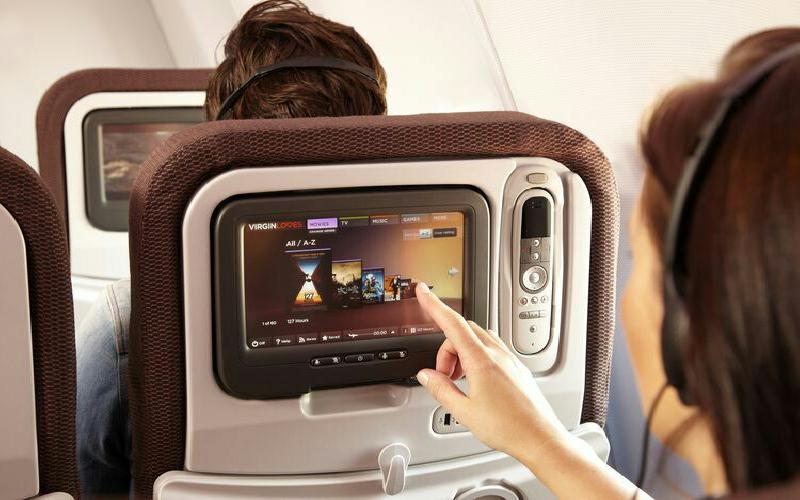Airline passengers prefer to stay connected over watching movies in-flight


Airlines are working on several tech developments, including those that improve in-flight entertainment for passengers. Studies show that the demand for in-flight connectivity is steadily increasing.
In about ten years, frequent travelers and first-time passengers will experience flying in a windowless plane that seeks to reduce fuel usage and increases onboard safety. A UK aerospace firm confirmed this concept by releasing images of the windowless plane prototype in a Telegraph report in 2014. The futuristic concept hopes to revolutionize air travel by improving in-flight entertainment (IFE) through cabins lined with thin screens that display films, work presentations or even the surrounding landscapes.
Until that day comes, passengers will have to be contented with the current IFE systems that airlines have to offer, but this does not mean that in-flight entertainment in today’s aircraft is low tech.
A Digital Trends report revealed that IFE’s in today’s aircraft no longer mean long presses on the screen and neck strains on hard-to-see monitors. IFE’s have become sophisticated, high-tech computers loaded with movies, music streaming capabilities, wireless setups and even interactive maps. Reports estimate that airlines spend nearly $20 million a year on IFE content alone and hardware can cost up to $5 million per aircraft.
Virgin America’s Red entertainment system runs on a modified Android version using Panasonic’s EcoV2 monitors that boast of a tablet-like feel with pinch and zoom capabilities. Virgin America has also revolutionized its audio by working with audio-tech startup Dysonics, a company that simulates 3D sound experience to bring surround sound to passengers.
OpenSkies, a company owned by British Airways, have also adopted new entertainment technology where passengers are handed out pre-loaded iPads that are packed with ample entertainment content.
On the other hand, Australia’s Sunshine Coast Daily reported that the imminent death of in-flight movies is about to take place as a new consumer trend grows.
The country’s flag carrier airline, Qantas, saw the growing trend on binge watching, and as a result has overhauled its IFE systems. After an 18-month review, the airline has made it apparent that consumer trends led to binge watching, which meant consuming a lot of content, especially in long haul flights.
Last year, Qantas partnered with Samsung to offer its passengers the virtual reality experience using the Samsung Gear VR headsets. Now, passengers are able to watch their favorite movies in 360 degrees while traveling.
“You’re sitting at home in your lounge, you’ve got Netflix, Apple TV, on demand TV and Spotify and it’s all on multiple devices. People would get on a plane and find it didn’t have the wow factor anymore,” said Qantas head of digital entertainment brand and marketing corporate affairs, Jo Boundy.
In-flight connectivity
A boost in internet connectivity and high-speed Wi-Fi are becoming the passengers’ primary demand these days. A study conducted by AT&T in partnership with civil and avionics product manufacturer, Honeywell, showed that 13 percent of passengers in the U.S., 17 percent in the UK and 22 percent in Singapore were willing to boost internet connectivity even if it meant giving up going to the bathroom.
A surprising 42 percent of passengers surveyed in the U.S., 34 percent in the UK, and 41 percent in Singapore, were even willing to give up ordering in-flight food and water in exchange for surfing the internet. Researchers also revealed that passengers have an “insatiable appetite” for connectivity that they even bring their own mobile devices in hopes of connecting onboard.
“Well, let’s face it: the two mega trends of our era have been mobile communications and the Internet, and those two things are feeding each other and causing additional growth as a consequence of that,” said 5BARz international chairman and former Apple CEO Gil Amelio in an interview where he discussed 5BARz International mobile booster technology.
The company has revolutionized mobile connectivity through its network extender device that amplifies indoor mobile signals.
Some of the world’s biggest airlines have already adopted onboard connectivity in their IFE systems including Lufthansa. The German airline’s streaming-based IFE system called board connect lets passengers access entertainment from their own devices using onboard WiFi. The concept is similar to bring-your-own-device (BYOD) solutions where everyone can carry their own device onboard and connect to aircraft’s wi-fi.
KLM followed suit when it released its revolutionized IFE system that includes the use of electronic devices and connecting to onboard wi-fi. Passengers also enjoy their favorite social media apps. The airline has a dedicated app that let viewers see the latest films, TV show, music, and even children’s programs.
As in-flight systems continue to evolve, the line between connectivity and entertainment begins to blur, from the adoption of virtual reality gears to movies streamed online. The era of wireless in-flight entertainment has already begun where passengers are given a multitude of options based on their entertainment preference. Consequently, entertainment decisions that airlines make are based on consumer trends and careful studies.
Hi everyone, Today I am here going to teach you how to recover permanently deleted data from the hard drive. The method which I will describe here, it is based on windows 7..
Market share figures for search engines in October 2017 were released. And these confirm the monopoly of Google..
Any smartphone user in the current social paradigm does understand the vitality of a mobile app. Short for "application," an app has seemingly transformed the meaning of mobility..